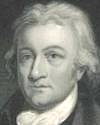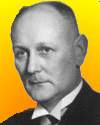
On 24 Apr 1743, Edmund Cartwright was born, the English inventor of the power loom which revolutionized weaving, changing it from a manual process to a mechanical one.
His contribution to the Industrial Revolution was immense, yet it is remarkable that he began his life taking holy orders, and publishing poems, and followed those pursuits until his fortieth year. It was only then that his interest in invention was awakened.
The success of his power looms threatened the livelihoods of manual workers, and he suffered losses from mobs attacking them. Despite holding patents, he ultimately derived little long-term benefit, but was granted a sum by Parliament to live on in his later years, for his invention's service to the nation.
You can learn more by reading this short biography of Edmund Cartwright, a chapter from Self-Made Men (1858).

On 24 Apr 1958, Richard B. Goldschmidt died. Today's book pick is: The Material Basis of Evolution: Reissued (The Silliman Memorial Lectures Series), by Richard B. Goldschmidt. In this book, Goldschmidt critiques the classical Darwinian-Wallace theory of evolution and inquires into the types of hereditary differences that produce new species. Goldschmidt used a wide range of research to formulate his own picture of evolution. Contrary to near-unanimity among scientists, he insisted that the neo-Darwinian theory of micromutations applied only within species and was no longer tenable as a general theory of evolution. Instead, Goldschmidt claimed, macroevolution resulted from larger jumps in genotype - across “bridgeless gaps” - related either to systemic mutations or to mutations affecting early development.
It is available from Amazon, typically about New from $40.46. Used from $3.75. (As of earlier time of writing - subject to change.)
 | There are still many unsolved problems about bird life, among which are the age that birds attain, the exact time at which some birds acquire their adult dress, and the changes which occur in this with years. Little, too, is known about the laws and routes of bird migration, and much less about the final disposition of the untold thousands which are annually produced. |
 | I have accumulated a wealth of knowledge in innumerable spheres and enjoyed it as an always ready instrument for exercising the mind and penetrating further and further. Best of all, mine has been a life of loving and being loved. What a tragedy that all this will disappear with the used-up body! |
 | Now having (I know not by what accident) engaged my thoughts upon the Bills of Mortality, and so far succeeded therein, as to have reduced several great confused Volumes into a few perspicuous Tables, and abridged such Observations as naturally flowed from them, into a few succinct Paragraphs, without any long Series of multiloquious Deductions, I have presumed to sacrifice these my small, but first publish'd, Labours unto your Lordship, as unto whose benign acceptance of some other of my Papers even the birth of these is due; hoping (if I may without vanity say it) they may be of as much use to persons in your Lordships place, as they are of none to me, which is no more than fairest Diamonds are to the Journeymen Jeweller that works them, or the poor Labourer that first digg'd them from Earth. [An early account demonstrating the value of statistical analysis of public health data. Graunt lived in London at the time of the plague epidemics.] |
| Before you look at today's web page, see if you can answer some of these questions about the events that happened on this day. Some of the names are very familiar. Others will likely stump you. Tickle your curiosity with these questions, then check your answers on today's web page. | |
| Births | |
 | Robert Porter Allen, born 24 Apr 1905, was an American author and conservationist recognized for saving a certain large bird from extinction by discovering (1955) the nesting ground of the sole remaining flock near the Arctic Circle. He was a leader in having its habitats in Texas and Canada proclaimed as refuges. He also helped establish a working protective plan for flamingos and recommended methods of saving the small surviving colonies of roseate spoonbills, thus helping to perpetuate the species. What bird is Allen recognized for saving from extinction? |
 | Jean-Charles-Galinard de Marignac, born 24 Apr 1817, was a Swiss chemist whose life work consisted of making many precise determinations of atomic weights. In 1878, he heated and decomposed some erbium nitrate obtained from gadolinite. Extracting the product with water he obtained two oxides. One, a red substance he named erbia. The discovered the second, colourless one contained a new element, which he also named. (He was later also a co-discoverer of gadolinium.) What element was contained in the colorless oxide extracted from gadolinite? |
| Deaths | |
 | Gerhard Domagk (1895-1964) was a bacteriologist and pathologist who was awarded a Nobel Prize for Physiology or Medicine for his discovery (1932) of the antibacterial effects of Prontosil, the first of the sulfonamide drugs. He was the first person to refuse to accept the prize at the time of the award, although he did accept it 15 years later. Why did Domagk at first refuse his Nobel Prize? |
| Events | |
 | On 24 Apr 1925, Darwin’s theory of evolution was taught on this day by teacher John Scopes. He was prosecuted under a 21 Mar 1925 state law, the Butler Act, against the teaching of evolution in public schools. He was convicted and fined $100. On appeal, Scopes was acquitted on a technicality. Which state passed the Butler act? |
 | On 24 Apr of a certain year, the People’s Republic of China became the fifth nation with a satellite in orbit with the launch of DFH-1, from Jiuquab Satellite Launch Center. It had a design life of 15 days, and for propaganda, it transmitted the Communist China national anthem. In which decade was the first Chinese satellite launched? |
Fast answers for the previous newsletter for April 23: “how much” • diffraction • artificial skin (treating burns) • first U.S. satellite to impact on the Moon surface • a sequence of pictures lined the inside wall of a shallow spinning cylinder, viewed from the outside through vertical slits between the images.
 If you enjoy this newsletter, the website, or wish to offer encouragement or ideas, please send feedback by using your mail reader Reply button.
If you enjoy this newsletter, the website, or wish to offer encouragement or ideas, please send feedback by using your mail reader Reply button. Your click on a Facebook, StumbleUpon, or other social button on the site webpages is also a welcome sign of appreciation. Thank you for using them.
© This newsletter is copyright 2020 by todayinsci.com. Please respect the Webmaster's wishes and do not put copies online of the Newsletter — or any Today in Science History webpage. (If you already have done so, please remove them. Thank you.) Offline use in education is encouraged such as a printout on a bulletin board, or projected for classroom viewing. Online, descriptive links to our pages are welcomed, as these will provide a reader with the most recent revisions, additions and/or corrections of a webpage. For any other copyright questions, please contact the Webmaster by using your mail reader Reply button.
--
If you do not want to receive any more newsletters, Unsubscribe
To update your preferences and to unsubscribe visit this link
Executive Real Estate Business Class
-
"It was like a man with wings. It wasn't like anything you'd see on TV or in a monster movie." ...
About the publisher
Search This Blog
Blog Archive
-
▼
2021
(585)
-
▼
April
(57)
- On This Day for April 30 - George Washington inaug...
- Newsletter for Friday 30 April.
- On This Day for April 29 - British royal wedding, ...
- Newsletter for Thursday 29 April.
- On This Day for April 28 - Benito Mussolini execut...
- Newsletter for Wednesday 28 April.
- On This Day for April 27 - Independence for Sierra...
- Newsletter for Tuesday 27 April.
- On This Day for April 26 - Chernobyl nuclear accid...
- Newsletter for Monday 26 April.
- On This Day for April 25 - Hubble Space Telescope ...
- See How They Tracked Down Bin Laden
- Newsletter for Sunday 25 April.
- On This Day for April 24 - Installation of Pope Be...
- Newsletter for Saturday 24 April.
- On This Day for April 23 - Voting for Eritrea's in...
- Earth Day Bonus: Become a Climate Action Expert
- On This Day for April 22 - First Earth Day, Miguel...
- On This Day for April 21 - French elections held, ...
- Newsletter for Wednesday 21 April.
- On This Day for April 20 - Explosion on the Deepwa...
- Newsletter for Tuesday 20 April.
- On This Day for April 19 - American Revolution beg...
- Newsletter for Monday 19 April.
- On This Day for April 18 - The midnight ride of Pa...
- Newsletter for Sunday 18 April.
- On This Day for April 17 - Canada Act proclaimed, ...
- Newsletter for Saturday 17 April.
- On This Day for April 16 - Harriet Quimby's flight...
- Newsletter for Friday 16 April.
- On This Day for April 15 - Sinking of the Titanic,...
- Newsletter for Thursday 15 April.
- On This Day for April 14 - Abraham Lincoln shot, J...
- On This Day for April 13 - Alfred Dreyfus imprison...
- Newsletter for Tuesday 13 April.
- On This Day for April 12 - Launch of first space s...
- Newsletter for Monday 12 April.
- John of Gaunt: father of England’s medieval monarchy
- On This Day for April 11 - Napoleon's abdication a...
- Newsletter for Sunday 11 April.
- On This Day for April 10 - Anschluss approved in A...
- On This Day for April 9 - Fall of Baghdad, Jørn Ut...
- Newsletter for Friday 9 April.
- On This Day for April 8 - Celebration of the Buddh...
- On This Day for April 7 - Jack Nicklaus's first Ma...
- Newsletter for Wednesday 7 April.
- On This Day for April 6 - Olympics revived, Raphae...
- On This Day for April 5 - Battle of Maipú, Colin P...
- The history and origins of Easter
- On This Day for April 4 - Martin Luther King, Jr.,...
- Newsletter for Sunday 4 April.
- On This Day for April 3 - Implementation of the Ma...
- Newsletter for Saturday 3 April.
- On This Day for April 2 - Death of Pope John Paul ...
- Newsletter for Friday 2 April.
- On This Day for April 1 - Creation of Nunavut, Ser...
- Newsletter for Thursday 1 April.
-
▼
April
(57)
-
Blogroll
-
About
HistoryFact










0 comments:
Post a Comment